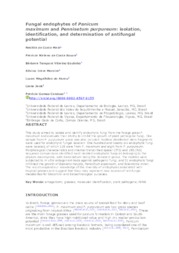Fungal endophytes of Panicum maximum and Pennisetum purpureum: isolation, identification, and determination of antifungal potential.
Fungal endophytes of Panicum maximum and Pennisetum purpureum: isolation, identification, and determination of antifungal potential.
Author(s): MAIA, N. da C.; SOUZA, P. N. da C.; GODINHO, B. T. V.; MOREIRA, S. I.; ABREU, L. M. de; JANK, L.; CARDOSO, P. G.
Summary: This study aimed to isolate and identify endophytic fungi from the forage grass P. maximum and evaluate their ability to inhibit the growth of plant pathogenic fungi. One sample from P. purpureum grass was also included. Surface disinfected stem fragments were used for endophytic fungal isolation. One hundred and twenty-six endophytic fungi were isolated, of which 118 were from P. maximum and eight from P. purpureum. Morphological characteristics and internal transcribed spacer (ITS) and 18S (NS) sequence comparisons identified most isolated endophytic fungi as belonging to the phylum Ascomycota, with Sarocladium being the dominant genus. The isolates were subjected to in vitro antagonism tests against pathogenic fungi, and 31 endophytic fungi inhibited the growth of Bipolaris maydis, Penicillium expansum, and Sclerotinia minor. The results expand our knowledge of the diversity of endophytes associated with tropical grasses and suggest that they may represent new sources of antifungal metabolites for biocontrol and biotechnological purposes.
Publication year: 2018
Types of publication: Journal article
Unit: Embrapa Beef Cattle
Keywords: Antagonism, Grasses, Molecular identification, Plant pathogens, RDNA
Observation
Some of Embrapa's publications are published as ePub files. To read them, use or download one of the following free software options to your computer or mobile device. Android: Google Play Books; IOS: iBooks; Windows and Linux: Calibre.
Access other publications
Access the Agricultural Research Database (BDPA) to consult Embrapa's full library collection and records.
Visit Embrapa Bookstore to purchase books and other publications sold by Embrapa.

